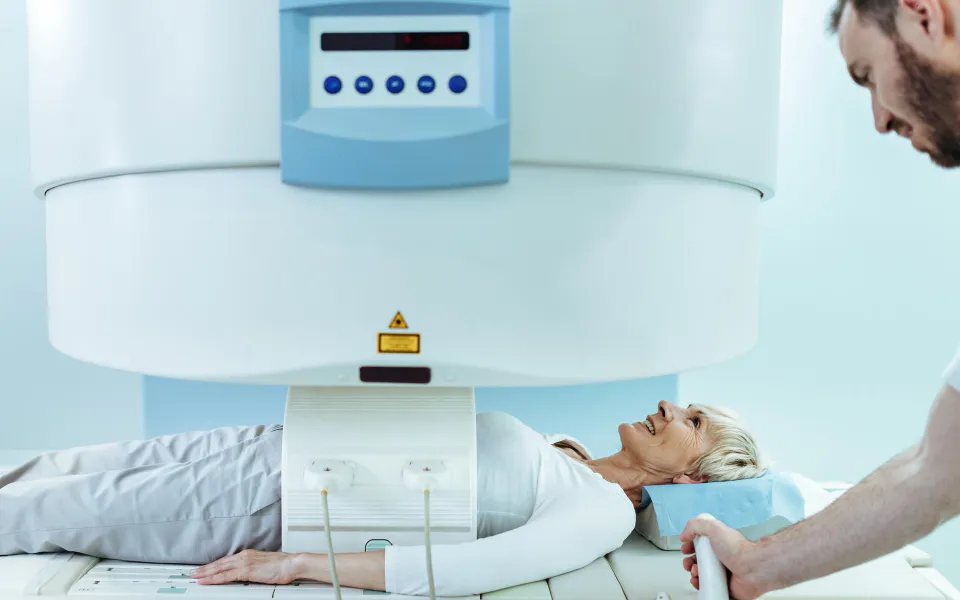Dual-energy X-ray absorptiometry (DEXA or DXA) is a widely used imaging method that plays a crucial role in evaluating bone density. It is especially effective in detecting bone weakening conditions such as osteopenia and osteoporosis. As the global population continues to age, DEXA scans are becoming increasingly important in both preventive healthcare and long-term bone health management.
Healthcare providers - from diagnostic technicians to hospital leadership - benefit from a thorough understanding of how DEXA technology supports decision-making in patient care, resource planning, and public health initiatives.
What Happens During a DEXA Scan?
DEXA scans utilize two X-ray beams set at different energy levels to analyze bone density, focusing primarily on areas prone to fractures, like the spine and hips. This technique is known for its low radiation exposure and high level of precision. A trained technologist, often under the supervision of a physician, conducts the scan and ensures the machine is properly operated and the patient is positioned correctly.
While its main application is identifying bone loss, DEXA can also be used to monitor bone changes over time and to evaluate how well treatment is working. In some advanced systems, it even provides insights into body fat and muscle distribution. Although the scan doesn’t detect fractures directly, it helps pinpoint areas at risk for breaks, supporting earlier medical intervention.
Access and share your medical images effortlessly with Scriptoware’s Dicom Image Viewer.
Try Now !How Reliable Are DEXA Results?
DEXA scans are often considered the gold standard for diagnosing osteoporosis, particularly when making decisions about treatment for borderline cases. The method typically provides more accurate measurements of bone density compared to other screening techniques.
Still, like all diagnostic procedures, DEXA has some limitations. Measurement errors can occur if the machine isn't calibrated correctly, if the patient is not positioned properly, or if there are interfering factors such as metal implants or spinal abnormalities. Despite these challenges, when the procedure is performed correctly, DEXA provides reliable results that are trusted by clinicians worldwide.
To ensure quality, many healthcare facilities follow strict protocols, perform regular equipment checks, and invest in training for technologists to maintain accuracy.
How Does DEXA Compare to Other Bone Assessment Tools?
One frequent question in bone health evaluation is how DEXA stands up against other diagnostic options like quantitative computed tomography (QCT). While QCT can offer detailed 3D imaging, DEXA is preferred for routine screening because it is less invasive, more affordable, quicker, and exposes patients to less radiation. Numerous studies support the clinical reliability of DEXA for both initial evaluations and ongoing monitoring.
Who Should Consider Getting a DEXA Scan?
The timing of a DEXA scan depends on individual risk factors, medical background, and professional recommendations. Most clinical guidelines suggest baseline screening for:
- Women aged 65 and above
- Men aged 70 and older
Earlier testing may be appropriate for individuals with certain risk indicators - such as prolonged steroid use, low body weight, smoking history, or a family background of osteoporosis.
Younger postmenopausal women with identifiable risk factors are also often candidates for testing. Guidance from expert panels, like the U.S. Preventive Services Task Force, helps shape these recommendations and ensures consistency in care.

What to Expect During the Exam
The DEXA scan procedure is typically quick and straightforward, lasting around 10 to 20 minutes. Most appointments are completed in less than half an hour, making it a convenient option for both patients and clinics. The scan is painless, and results are often reviewed soon after the exam, helping clinicians make timely decisions about treatment or further testing.
Interpreting DEXA Scan Outcomes: Bone Density Scores, Cost Breakdown, and Operational Best Practices
Dual-energy X-ray absorptiometry (DEXA) scans are a cornerstone in the diagnosis and monitoring of bone health. Understanding the interpretation of results, associated costs, and how to effectively integrate this technology into a clinical setting is essential for both medical professionals and healthcare administrators.
Decoding DEXA Scan Scores: What Do T-Scores and Z-Scores Mean?
When reviewing a DEXA scan report, two key metrics are commonly assessed: the T-score and the Z-score.
- T-scores represent how a patient’s bone density compares to that of a healthy 30-year-old adult of the same sex. This benchmark helps clinicians determine the degree of bone loss
- Z-scores, by contrast, compare a patient's bone density to the average for their age, sex, and size, making them more useful for identifying unusual patterns in younger individuals or those with unexpected bone thinning.
T-Score Interpretation:
- Above -1.0:Bone density is considered within the normal range
- Between -1.0 and -2.5:Indicates osteopenia, a condition where bone mass is lower than normal but not yet in the osteoporosis range
- Below -2.5:Suggests osteoporosis, a condition associated with a heightened risk of fractures
Optimize your imaging workflow with Scriptoware's Cloud PACS
Learn MoreAs bone density deviates further below normal levels, the risk of fractures increases significantly. For instance, a T-score of -1.0 roughly doubles the risk of fracture compared to the average young adult. If an individual has suffered fractures and also has a T-score below -2.5, the condition is classified as severe osteoporosis.
Z-Score Significance:
A Z-score below -2.0 may suggest that other factors besides normal aging such as chronic illness or medication side effects are contributing to bone loss. While T-scores guide treatment decisions, Z-scores prompt further investigation into underlying causes.
Evaluating the Severity of Bone Loss
To maintain accuracy and consistency, implementing standardized protocols is critical. This includes training staff members thoroughly on best practices for patient positioning, machine operation, and performing regular equipment calibration checks. These steps ensure the highest quality of diagnostic results while minimizing error margins.
Accuracy and Reliability of Results
While DEXA scans are highly dependable, slight variations can occur, especially when measurements are near diagnostic thresholds. In such cases, repeat imaging or alternative assessments might be used. Nevertheless, when combined with clinical risk factors, DEXA remains a trusted and standardized method for guiding care decisions.
Financial Considerations: DEXA Scan Pricing and Insurance Coverage
What Does a DEXA Scan Cost?
DEXA scan fees vary widely depending on geographic location, the facility type (hospital or outpatient center), and whether the scan is part of a broader diagnostic package.
- Typical price range:$50 to $300
- Average out-of-pocket expense:$160 to $175 for those without insurance
Patients frequently ask about insurance coverage. While most health plans cover DEXA scans if there’s a medical indication such as a history of fractures or risk factors like steroid use, some may require pre-authorization.
Medicare and Insurance Guidelines
For providers serving older populations, understanding Medicare’s reimbursement rules is essential. Medicare generally covers bone density scans once every 24 months assuming the patient meets specific risk criteria such as:
- Osteoporosis or osteopenia diagnosis
- History of fractures related to bone fragility
- Hormonal conditions like estrogen deficiency
- Use of medications known to reduce bone density
Medicare does not usually approve routine DEXA scans unless there is a documented clinical need. Providers must document risk factors to ensure reimbursement.
Send your DEXA scans to your doctor Free of Cost
Sign up with ScriptowareClinical Integration and Operational Insights
Optimizing Workflow with DEXA Technology
From a management standpoint, DEXA machines can enhance patient flow due to their short scan time, typically under 20 minutes. This efficiency makes it easier to incorporate into regular outpatient imaging schedules while supporting early intervention for patients at risk of fractures.
Protocol Standardization and Quality Assurance
Maintaining consistency in image quality and diagnostic accuracy depends on:
- Routine equipment calibration
- Proper patient positioning
- Staff training and certification in DEXA procedures
Developing and adhering to standard operating procedures across departments ensures reliability and minimizes interpretation errors.
Broadening Your Service Portfolio with DEXA Technology
DEXA (Dual-Energy X-ray Absorptiometry) devices now offer more than just bone density measurement. Many systems come equipped with body composition analysis features, providing valuable metrics on muscle mass, fat distribution, and visceral fat levels. This addition is particularly beneficial for clinics focused on:
- Weight management and nutritional counseling
- Fitness and rehabilitation programs
- Sports medicine and athletic performance
By adopting body composition capabilities, healthcare providers can expand their service range and unlock new revenue opportunities. It is important, however, to ensure staff receive thorough training to interpret these results accurately and apply them effectively in patient care.
Common Questions About DEXA Scanning
Are DEXA scans dependable for early osteoporosis detection?
DEXA is widely recognized as a highly dependable method for measuring bone density. It involves minimal radiation exposure and produces consistent, precise results over repeated scans.
How reliable are DEXA scans in routine clinical practice?
Accuracy remains high when scans are performed correctly. Operator expertise, proper equipment calibration, and correct patient positioning are key factors for reliable outcomes.
How reliable are DEXA scans in routine clinical practice?
Accuracy remains high when scans are performed correctly. Operator expertise, proper equipment calibration, and correct patient positioning are key factors for reliable outcomes.
Do spinal abnormalities affect DEXA scan accuracy?
Certain spinal issues or the presence of implants may impact scan readings. Radiologists must take these factors into account during analysis to avoid misinterpretation.
Which diagnoses qualify for Medicare coverage of DEXA scans?
Medicare generally provides coverage for DEXA scans related to osteoporosis screening, estrogen deficiency, and specific bone health treatments.
What do T-scores and Z-scores indicate in DEXA reports?
- T-scores assess bone density compared to a young, healthy reference population to classify bone health status.
- Z-scores compare an individual’s bone density with age- and sex-matched norms to highlight abnormal bone loss.
The Importance of DEXA in Bone Health Care
DEXA scans are a cornerstone in bone health assessment across North America, delivering quick, accurate measurements with very low radiation exposure. Ensuring precision relies on following standardized procedures and regular device calibration, especially in busy clinical environments.
Healthcare providers must decide when to initiate screening and whether borderline results require follow-up scans. DEXA provides critical, trustworthy data to guide these clinical decisions.
Administrators should consider the financial benefits of offering DEXA scans, including insurance reimbursements and the potential to reduce costly fracture-related treatments. Familiarity with insurance policies, including Medicare, can simplify scheduling and billing processes.
Educating patients on appropriate timing for screening helps prevent progression to severe bone disease.
Improving Patient Care with a Comprehensive DEXA Program
Integrating DEXA scan data with targeted follow-up interventions - such as lifestyle changes, supplements, or medications - can significantly improve patient health outcomes. Adding body composition analysis enhances diagnostic insight, supporting broader clinical applications.
A well-designed DEXA program not only facilitates informed medical decisions but also enhances your facility’s standing as a trusted center for preventive and diagnostic bone care.
